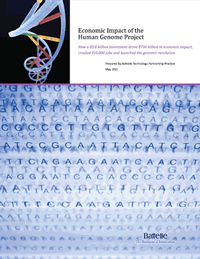Last updated: June 12, 2013
Calculating the economic impact of the Human Genome Project
Jonathan Max Gitlin, Ph.D.
Science Policy Analyst
 Public funding of scientific R&D has a significant positive impact on the wider economy, but quantifying the exact impact of research can be difficult to assess. A new report by research firm Battelle Technology Partnership Practice estimates that between 1988 and 2010, federal investment in genomic research generated an economic impact of $796 billion, which is impressive considering that Human Genome Project (HGP) spending between 1990-2003 amounted to $3.8 billion. This figure equates to a return on investment (ROI) of 141:1 (that is, every $1 invested by the U.S. government generated $141 in economic activity). The report was commissioned by Life Technologies Foundation.
Public funding of scientific R&D has a significant positive impact on the wider economy, but quantifying the exact impact of research can be difficult to assess. A new report by research firm Battelle Technology Partnership Practice estimates that between 1988 and 2010, federal investment in genomic research generated an economic impact of $796 billion, which is impressive considering that Human Genome Project (HGP) spending between 1990-2003 amounted to $3.8 billion. This figure equates to a return on investment (ROI) of 141:1 (that is, every $1 invested by the U.S. government generated $141 in economic activity). The report was commissioned by Life Technologies Foundation.
According to the study, Economic Impact of the Human Genome Project, the benefits have been widespread and increasing over time. HGP produced 3.8 million job-years of employment, or one job-year for each $1,000 invested. Personal income generated by HGP (wages and benefits) exceeded $244 billion over the time frame, averaging out to $63,700 income per job-year. Since the HGP's completion in 2003, federal investment in genomic research has actually increased. In 2010 dollars, HGP spending by the National Institutes of Health (NIH) and the Department of Energy (DOE) amounted to $5.6 billion; for the seven years following, federal genomics spending totaled $7.2 billion dollars.
In 2010 alone, genomics directly supported more than 51,000 jobs, and indirectly supported more than 310,000 jobs, according to the Battelle study. This created $20 billion in personal income and added $67 billion to the U.S. economy.
The government has even been repaid for its HGP spending. Last year, tax revenues returned to federal, state and local governments nearly equaled the entire 13-year investment in the HGP. Genomics-enabled industry generated more than $3.7 billion in federal taxes and $2.3 billion in U.S. state and local taxes in 2010.
Importantly, the scientific and economic benefits of investing in the HGP are growing, the report finds. The impact on medicine, agriculture, energy and the environment are still in their early stages, with the promise of great things to come.
Another report on the economic impact of NIH funding - An Economic Engine: NIH Research, Employment and the Future of the Medical Innovation Sector - released on the same day as the Battelle report assessed the economic impact of NIH's 2010 budget on the larger economy. The report finds that the $31.2 billion investment in NIH during 2010 created nearly 488,000 jobs and generated more than $68 billion for the U.S. economy, with benefits in every state in the Union. United for Medical Research, a coalition of universities, patient advocacy groups, and life science and pharmaceutical firms published the study. Moving forward, NIH, along with other federal agencies including the National Science Foundation and the White House Office of Science and Technology Policy is beginning to track the impact of federal science funding on the economy through an initiative called "Science and Technology for America's Reinvestment: Measuring the Effect of Research on Innovation, Competitiveness and Science," or STAR METRICS [starmetrics.nih.gov].
Report methodology
Battelle measured economic impact using an input/output model to represent the interrelationships between economic sectors. Three different kinds of economic impact were included: direct, indirect and induced. Direct impact means the specific expenditures, such as each year's NIH and DOE funding on genomics, or specific spending by a given economic sector such as pharmaceuticals on genomics-related research. Indirect impacts are those on suppliers to those industries, such as companies that provide services, reagents, equipment and so on. Finally, induced impacts are the follow-on effect of the suppliers and employees spending money in the general economy.
These impacts were calculated using IMPLAN, a software platform that is widely used for calculating economic impacts. Battelle looked at six economic sectors that were mapped to the closest economic sectors incorporated into IMPLAN.
These were as follows (IMPLAN sector in parentheses):
- Genomics-Related Bioinformatics (Custom computer programming services)
- Genomic & Related Testing (Medical and diagnostic labs)
- Genomic-Related Biologics & Diagnostic Substances (Biologics & diagnostics)
- Genomic Instruments & Equipment (Analytical laboratory instrument mfg)
- Genomics R&D/Genomics Biotech (Scientific R&D services)
- Drugs & Pharmaceuticals (Drugs & pharmaceuticals)
The model looks at trade flows between these sectors across the U.S. economy for a 23 year period (1988-2010) and estimates impacts on "employment, personal income (including both wages and benefits), economic output, state and local tax revenue (including income and property taxes), and federal tax revenue (including contributions to Social Security)."
